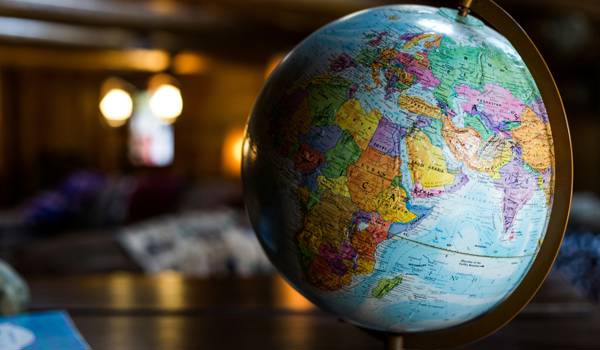Realistic travel costs for your round-the-world adventure
Planning a Round-the-World (RTW) trip? You don’t need to be rich to make it happen. With smart budgeting, strategic planning, and a few travel hacks, you can stretch your cash and see the world without blowing your savings. Here’s how to budget for your trip, track your spending, and save money along the way.

Round-the-World Flight Routes
How Much a RTW Flight Costs
A round-the-world ticket enables you to circumnavigate the world on a single itinerary with multiple airlines. It's a great way to cover a number of different cities across multiple continents in one epic trip.
If you stick to the main airline hubs (usually capital cities with large airports served by multiple airlines), you can save money with a round-the-world ticket compared to buying individual one-way flights.
The cost of a RTW flight ticket can vary wildly depending on your route and the number of stops. These tickets are usually valid for 12 months, so you have up to one year to explore as much of the world as you can afford to. These types of tickets often allow free date changes too - great if you might change your mind and stay longer in a place.
To help give you an idea of costs, here are some popular RTW journeys and a guide price.
The Classic Loop
🗺️ UK - Bangkok - Hong Kong - Sydney - Los Angeles - UK
💰 From £2,139 per person including taxes
The LA to OZ
🗺️ UK - Sydney - Auckland - Fiji - Los Angeles - UK
💰 From £2,169 per person including taxes
Taj to Toronto
🗺️ UK - Delhi - Sydney // Brisbane - Vancouver - Toronto - UK
💰 From £2,245 per person including taxes
The KL to BA
🗺️ UK - Kuala Lumpur - Brisbane // Sydney - Santiago de Chile - Buenos Aires - UK
💰 From £2,219 per person including taxes
Round-the-world flights can be tailored to your travel wish list, but it often works well if you consider a portion of overland travel between two hubs. This gives you the opportunity for more travel while skipping a flight to use for another leg of your round-the-world flight itinerary.

More budgeting tips for your trip
How Much RTW Travel Costs Per Day (by continent)
Budgeting for a round-the-world trip can feel overwhelming, but breaking it down by continent makes it easier. Below, we’ve listed average daily budgets for each region, covering accommodation, food, transport, and activities. Keep in mind that travel style (budget vs. mid-range) and specific countries within each region will impact your costs.
Asia – £25–£40 per day
In general, Asia is a pretty cheap continent to travel to, and good overland and budget flight connections mean you'll have no problem hopping from place to place. Southeast Asia is the most budget friendly, while countries in East Asia have a price level more comparable to the European average.
💰 Budget travel: Hostels (£10–£15), street food (£1.50-£4 per meal), local transport (£1–£3 per ride)
💎 Mid-range: Private rooms (£20–30), restaurant meals (£10–£15), guided tours (£20–£50)
➡️ Best for budget travellers: Southeast Asia (Thailand, Vietnam, Indonesia)
🚨 More expensive: Japan, South Korea, Singapore
South America – £40–£60 per day
South America is a mixed bag when it comes to budget travel. Countries like Bolivia, Peru, and Ecuador are great for backpackers, with cheap food, affordable accommodation, and decent public transport.
On the other hand, Chile, Argentina, and Brazil can be pricier, especially in big cities. Overland travel is an adventure, with long but scenic bus rides being the most affordable way to get around.
💰 Budget travel: Budget hotels/hostels (£10–£25), local food (£3-£7 per meal), buses (£5–£15 per trip)
💎 Mid-range: Boutique stays (£40–£80), sit-down restaurants (£10–£20), domestic flights (£50–£150)
➡️ Best for budget travellers: Bolivia, Peru, Colombia
🚨 More expensive: Chile, Argentina (Patagonia), Brazil’s big cities
Central America – £45–£70 per day
Central America is a great budget-friendly region, especially for backpackers. Countries like Guatemala, Nicaragua, and Honduras offer super cheap food, accommodation, and transport, while Costa Rica and Panama are pricier, especially in touristy areas.
Buses are the main way to get around, and street food is both delicious and affordable. If you're into adventure, activities like volcano hikes and snorkeling are budget-friendly compared to other parts of the world.
💰 Budget travel: Hostel dorms (£10–£20), local eateries (£3–£7), chicken buses (£2–£5)
💎 Mid-range: Boutique stays (£50–£100), organised tours (£30+), shuttles (£10–30)
➡️ Best for budget travellers: Guatemala, Nicaragua, El Salvador
🚨 More expensive: Costa Rica, Belize, Panama
Africa – £50–£80 per day
In Africa, your budget depends entirely on your travel style. You can go ultra-cheap by taking local buses, staying in budget hostels, and camping—or splurge on luxury lodges in popular wildlife reserves.
Safari costs vary by destination, with South Africa, Namibia, and Botswana offering the best value. A shared day safari in Etosha National Park costs around £60, making it an affordable way to experience the wildlife.
💰 Budget travel: Hostels/camping (£10–£30), cheap meals (£3–£10), local minibuses (£5–£20)
💎 Mid-range: Safari lodges (£80+), private transfers (£30+), excursions (£50–£200)
➡️ Best for budget travellers: South Africa, Namibia, Botswana, Uganda
🚨 More expensive: Safaris, Gorilla trekking, Kenya, Tanzania
Oceania – £70–£120 per day
Oceania, particularly Australia and New Zealand, is known for being expensive, especially for accommodation and transport. However, budget travellers can stretch their money with campervans, hostels, and working holiday opportunities.
The Pacific Islands vary widely in cost, with places like Fiji having budget options, while others lean towards luxury.
💰 Budget travel: Hostel dorms (£25–£50), self-catering (£5–£10 per meal), public transport (£5–£10 per day)
💎 Mid-range: Airbnb/private rooms (£80–£150), car rentals (£50+ per day), activities (£50–£200)
➡️ Best for budget travellers: Campervanning, working holiday jobs
🚨 More expensive: Australia & New Zealand’s cities, remote island destinations
North America – £80–£150 per day
North America is one of the most expensive continents to travel, with high costs for accommodation, transport, and food. The USA and Canada require solid budgeting, though road trips, hostels, and couch-surfing can help cut costs.
Mexico is much more budget-friendly, with cheap street food, affordable transport, and lower-cost activities.
💰 Budget travel: Cheap motels (£50+), fast food (£7–£12 per meal), buses (£20–£50)
💎 Mid-range: Hotels (£100–£200), restaurant meals (£15–£30), car rentals (£50-£100 per day)
➡️ Best for budget travellers: Road trips with friends, camping, budget airline deals
🚨 More expensive: USA’s big cities, Canada’s national parks

Budgeting tips for your RTW adventure
Track Your Spending Like a Pro
Before you even take off, get into the habit of tracking your expenses. Apps like Trail Wallet, TravelSpend, or even a simple spreadsheet can help you stay on top of your daily costs. The key is knowing how much you’re spending vs. how much you have left, so you don’t run out of cash halfway through your trip.
- Set a daily budget based on your destinations
- Record every expense, no matter how small (those £2 snacks add up!)
- Adjust as you go—if you overspend one day, cut back the next
Overland Travel vs. Flights: When to Choose What
Flights might seem like the fastest way to hop between countries, but they’re not always the best choice. Overland travel (buses, trains, ferries) can be cheaper, more scenic, and give you a better feel for a place. Plus, you’ll meet locals and fellow travellers along the way.
🚐 When to Go Overland:
✔️ You’re on a tight budget and need to save money
✔️ The route is scenic (like train travel in India or long-haul buses in South America)
✔️ You want to experience the journey, not just the destination
✈️ When to Fly:
✔️ Budget airlines (like AirAsia, Ryanair, or Jetstar) make it cheaper than overland travel
✔️ The journey takes more than 24 hours (some South American and African routes can be brutal)
✔️ Safety concerns—some border crossings are best avoided
Even if a flight is cheap, always weigh the cost vs. experience. A £20 flight might seem like a steal, but an overnight train through Vietnam or a slow boat in Laos could turn into one of your most memorable travel moments.

Short on Dough? Consider a Working Holiday
Funding a RTW trip can be tough, but a working holiday is a game-changer. If you’re between 18-30 (sometimes 35), countries like Australia, Canada, and New Zealand let you work while you travel, making it easier to fund your adventures.
- Jobs are easy to find in hospitality, retail, and agriculture
- You’ll meet tons of travellers doing the same thing
- It buys you more time to explore without burning through your savings
🌏 Why it’s worth it:
Picture this—spending a year in Australia, working at a beachside café in the mornings and road-tripping down the coast on weekends. You gain work experience, make new friends, and earn enough cash to keep travelling.
A working holiday lets you balance work and adventure, giving you the freedom to travel longer without going broke. And if you don’t want to commit to a full working holiday, you can also look into volunteering or work exchanges (like WWOOFing or Workaway) to cut costs.

